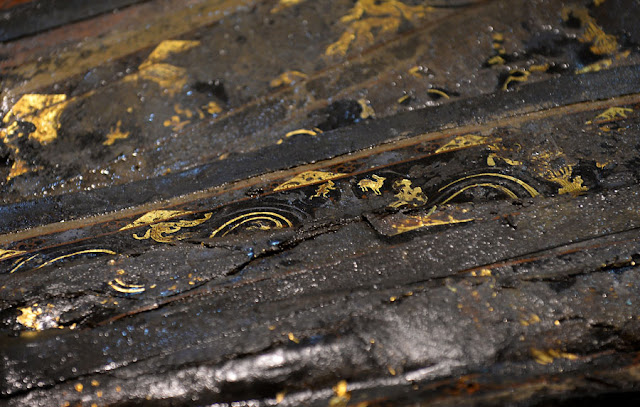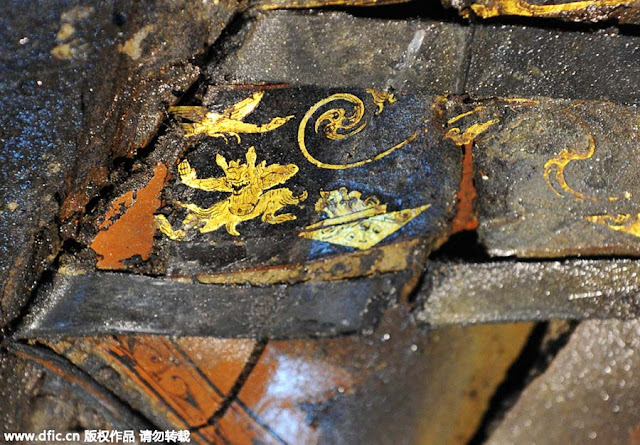Chinese archaeologists on Sunday opened the lid of the external coffin of a 2,000-year-old tomb, which they believe belong to a marquis of the Western Han Dynasty (206 BC - 24 AD).
They found a large number of gold and jade items, a piece of fine lacquerware decorated with gold foil in the space between the inner and external coffin.
The external plank is 3.4 meters long and 1.6 meter wide. They also discovered a painting of rosefinch on top of the inner coffin.
"We are glad to see the interior coffin is well preserved. There are lacquer paintings on its surface," said Xin Lixiang, who is in charge of the project.
Researchers believe the tomb belongs to Liu He, grandson of Emperor Wu, who held the title "Haihunhou," or "Marquis of Haihun." They hope to find his seal in the interior coffin, which would confirm the occupant's identity.
The Haihunhou mausoleum near Nanchang city, capital of East China's Jiangxi province, covers some 40,000 square meters with eight tombs and a chariot burial site and walls that stretch almost 900 meters.
China.org.cn, December 21, 2015
Photo taken on Dec. 20, 2015 shows gilded trunks unearthed from the main coffin in the Haihunhou (Marquis of Haihun) cemetery, east China's Jiangxi Province. The outer lid of the main coffin in the Haihunhou cemetery was opened on Sunday. According to archaeologists working at the site, relics inside the main coffin in the 2,000-year-old tomb of Haihunhou will likely reveal the occupant's identity. The Haihunhou cemetery near Nanchang City, capital of east China's Jiangxi Province, is the most complete known Western Han Dynasty (206 BC - 24 AD) cemetery. [Photo/Xinhua]
Photo taken on Dec. 20, 2015 shows gilded trunks unearthed from the main coffin in the Haihunhou (Marquis of Haihun) cemetery, east China's Jiangxi Province. The outer lid of the main coffin in the Haihunhou cemetery was opened on Sunday. According to archaeologists working at the site, relics inside the main coffin in the 2,000-year-old tomb of Haihunhou will likely reveal the occupant's identity. The Haihunhou cemetery near Nanchang City, capital of east China's Jiangxi Province, is the most complete known Western Han Dynasty (206 BC - 24 AD) cemetery. [Photo/Xinhua]
Owner of the 2,000-yr-old Chinese tomb to be revealed
Relics inside the main coffin in the 2,000-year-old tomb of Haihunhou (Marquis of Haihun) will likely reveal the occupant's identity, according to archaeologists working at the site.
The Haihunhou cemetery near Nanchang City, capital of east China's Jiangxi Province, is the most complete known Western Han Dynasty (206 BC - 24 AD) cemetery.
It covers some 40,000 square meters with eight tombs and a chariot burial site, with walls that stretch for almost 900 meters.
Researchers are excavating the main tomb, which is thought to belong to Liu He, grandson of Emperor Wu.
Three jade sword ornaments were found, entwined with gold, on the coffin. "The swords may be the last thing to put into the tomb, as a ritual, when they buried the dead," said Xu Changqing, director of Jiangxi cultural relics institute.
Yang Jun, leader of the excavation team, believes that the swords may have been worn by the owner when he paid respects to the emperor.
Archaeologists claim that there are many well-preserved relics inside the main coffin and are considering moving the coffin into the laboratory for further research. The work will be conducted in hypoxic conditions with archaeologists using oxygen equipment, Yang told Xinhua.
The excavation process is estimated to take more than ten days. "We are waiting for instructions from the State Administration of Cultural Heritage," said archaeologist Xin Lixiang.
Since 2011 when excavation began, more than 20,000 artifacts have been unearthed, including a portrait of Confucius, nearly 3,000 wooden tablets and bamboo slips and a large number of bronze, gold and jade items.









